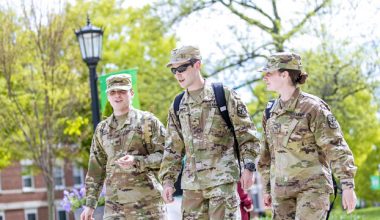If you’re unfamiliar with education, the term “intervention” may seem confusing.
Intervention in education is an approach schools use to support students struggling with academic, behavioral, or emotional difficulties.
It is a proactive and targeted approach to prevent the escalation of academic or behavioral challenges, helping students to reach their full potential.
This article will comprehensively explain intervention in education, including frequently asked questions.
Table of contents
- What is Intervention in Education?
- Why is Intervention Necessary in Education?
- What are the Types of Intervention in Education?
- Who Provides Intervention in Education?
- When is Intervention Needed in Education?
- How is Intervention Implemented in Education?
- What are the Benefits of Intervention in Education?
- Are There Any Challenges Associated with Intervention in Education?
- FAQs
- Conclusion
- References
- Recommendations
What is Intervention in Education?
Intervention in education refers to a proactive approach to support students experiencing academic, behavioral, or emotional difficulties.
It is a targeted and data-driven approach designed to prevent academic or behavioral challenges from escalating, ensuring students can achieve their full potential.
The purpose of intervention in education is to provide additional support to students struggling with learning difficulties, behavioral issues, or emotional challenges.
With the right intervention, students can catch up with their peers and succeed academically, socially, and emotionally.
Intervention in education can take various forms, including one-on-one support, small group instruction, or targeted programs.
The type of intervention provided will depend on the specific needs of the student and the resources available within the school or district.
One of the benefits of intervention in education is that it is a proactive approach that can prevent long-term academic and life consequences, such as dropping out of school or entering the juvenile justice system.
Intervention can also improve academic outcomes, increase graduation rates, and improve social and emotional well-being.
To implement intervention effectively, the first step is to identify struggling students and determine the underlying causes of their difficulties.
Based on this information, they develop a plan to provide the appropriate intervention, including small group instruction, one-on-one support, or targeted programs.
They then monitor the effectiveness of the intervention and make adjustments where need be.
Various professionals, including teachers, counselors, psychologists, and other support staff, can provide intervention in education.
The type of intervention and the provider will depend on the needs of the student and the resources available within the school or district.
See Also: 13 Affordable Accredited Homeschool Programs in 2023 | Best Reviews
Why is Intervention Necessary in Education?
Intervention in education is necessary because it provides a proactive approach to support students struggling academically, behaviorally, or emotionally.
Without intervention, these students may struggle, leading to long-term consequences such as dropping out of school, entering the juvenile justice system, or facing lifelong academic and social challenges.
Intervention is necessary to prevent academic or behavioral challenges from escalating. For example, a student struggling with reading may become frustrated and disengaged, leading to behavioral issues in the classroom.
These behavioral issues can escalate without intervention, leading to further disengagement, poor academic performance, and dropping out of school.
Intervention is also necessary to improve academic outcomes. When students receive targeted support to address their academic weaknesses, they can catch up with their peers and succeed academically.
This can lead to improved graduation rates, increased opportunities for post-secondary education, and better long-term outcomes in life.
Intervention is also necessary to support student’s social and emotional well-being. Many students who are struggling academically or behaviorally are also experiencing emotional challenges.
Students can develop coping skills, improve their self-esteem, and build positive relationships with peers and adults by providing targeted support to address these challenges.
Furthermore, intervention is necessary because it promotes equity in education.
Students from disadvantaged backgrounds may face more significant challenges than their peers, and without intervention, they may fall further behind.
By providing targeted support, schools can help level the playing field and give all students an equal opportunity to succeed.
See Also: What Is The Purpose Of The Community Safety Education Act
What are the Types of Intervention in Education?
Several types of interventions in education can be used to support students who are struggling academically, behaviorally, or emotionally.
Some of the most common types of interventions include:
#1. Academic Interventions
They design these interventions to support students who are struggling academically.
They may include strategies such as small group instruction, tutoring, or specialized programs that target specific academic areas.
#2. Behavioral Interventions
They design these interventions to support students who are struggling behaviorally.
They may include strategies such as behavior contracts, positive behavior reinforcement, or social skills training.
#3. Early Intervention
They design this intervention to identify and support students at risk of academic or behavioral challenges before they become more significant problems.
Early intervention may include screening assessments, progress monitoring, or targeted interventions for at-risk students.
Check Out: 21 Free Summer Programs for High School Students in 2023
#4. Individualized Interventions
They design these interventions to provide targeted support to individual students based on their unique needs.
They may include strategies such as individualized education plans (IEPs), 504 plans, or specialized interventions for students with specific learning needs.
#5. Classroom-wide Interventions
They design these interventions to support all classroom or grade-level students.
They may include strategies such as universal screening assessments, differentiated instruction, or classroom management techniques.
#6. School-wide Interventions
They design these interventions to support all students in a school.
They may include strategies such as positive behavior supports and interventions, school-wide reading or math programs, or school-wide social and emotional learning initiatives.
Check Out: Best Summer Program For High School Students in 2023
Who Provides Intervention in Education?
Intervention in education is a collaborative effort involving various professionals who work together to support students struggling academically, behaviorally, or emotionally.
The specific individuals who provide intervention in education may vary depending on the type of intervention and the student’s needs.
Teachers are often the first line of support for students struggling in the classroom.
They may provide academic interventions such as differentiated instruction, small group instruction, or targeted interventions to support individual student needs.
Teachers may also provide behavioral interventions such as behavior contracts, positive behavior reinforcement, or social skills training to help students who are struggling behaviorally.
School psychologists are trained professionals who provide various services to support students’ mental health and academic success.
They may provide individualized interventions such as counseling and behavioral or academic assessments to identify students’ strengths and challenges and provide targeted support.
Schools train special education teachers to provide specialized instruction and support to students with disabilities or learning challenges.
They may work with students who have individualized education plans (IEPs) or 504 plans to provide targeted interventions that meet their unique needs.
Speech-language pathologists are professionals who provide support to students who have communication challenges.
They may provide interventions such as speech therapy or language development activities to help students improve their communication skills.
Other professionals who may provide intervention in education include occupational therapists, physical therapists, social workers, and counselors.
Each of these professionals uniquely supports students’ academic, behavioral, and emotional needs.
See Also: 25 Best Fundraising Ideas for Schools in 2023 | Start Now
When is Intervention Needed in Education?
Intervention in education is necessary when students struggle academically, behaviorally, or emotionally.
It is important to identify students who need early intervention so that they can provide appropriate support to help them succeed.
Academic intervention may be needed when a student consistently performs below grade level or needs help to grasp the concepts they teach.
This may be identified through regular assessments, teacher observations, or parent concerns.
Academic intervention may involve targeted instruction, tutoring, or accommodations to help the student succeed.
Behavioral intervention may be needed when a student exhibits challenging behaviors that disrupt the learning environment. This may include behaviors such as defiance, aggression, or non-compliance.
Behavioral intervention may involve:
- Developing behavior plans.
- Implementing positive reinforcement strategies.
- Providing counseling to help the student learn coping strategies.
Emotional intervention may be needed when a student is experiencing mental health challenges such as anxiety, depression, or trauma.
Emotional intervention may involve counseling, therapy, or other mental health services to help students manage their emotions and improve their well-being.
Intervention may also be needed when a student has a disability or learning challenge that requires specialized support. The school may develop an individualized education plan (IEP) or 504 plan to provide targeted support and accommodations in these cases.
Check Out: Highest Paying Masters of Education Jobs In 2023 | Salary and Qualifications
How is Intervention Implemented in Education?
Intervention in education is implemented through a variety of strategies and approaches.
The specific approach will depend on the individual student’s needs and the type of intervention required.
Here are some common ways in which intervention is implemented in education:
#1. Targeted Instruction
Teachers may provide targeted instruction to students who are struggling academically.
This may involve additional one-on-one or small-group instruction, modified assignments, or alternative instructional strategies.
#2. Behavioral Plans
Students exhibiting challenging behaviors may develop a behavioral plan to help them learn appropriate behaviors and reduce disruptive behavior.
This may involve rewards for positive behavior or consequences for negative behavior.
#3. Counseling and Therapy
When a student is experiencing emotional or mental health challenges, counseling or therapy may be provided to help them learn coping strategies and improve their overall well-being.
#4. Special Education Services
Students with disabilities or learning challenges may receive special education services, such as an IEP or 504 plan, which provide targeted support and accommodations to help them succeed in school.
#5. Parent and Family Involvement
Parents and family members may be involved in the intervention process by attending meetings, providing feedback, and working with educators to develop strategies to support their child’s success.
#6. Collaborative Team Approach
Intervention in education often involves a collaborative team approach.
This is where educators, parents, and specialists work together to identify needs and develop interventions that best support the student’s success.
See Also: Which College Has Won The Most Heisman Trophies In 2023
What are the Benefits of Intervention in Education?
Intervention in education is critical to help students succeed academically and socially.
The benefits of intervention in education cannot be overstated, as it helps identify struggling students and provide them with the necessary support to improve their academic performance.
Now, we will discuss some of the benefits of intervention in education.
#1. Improved Academic Performance
One of the significant benefits of intervention in education is that it helps students to improve their academic performance.
When students receive additional support and resources, they can address learning gaps and improve their understanding of academic subjects.
#2. Increased Confidence
Students who receive intervention support tend to have increased self-confidence in their academic abilities.
As they receive targeted support, they can overcome challenges that were once a source of anxiety and frustration.
Intervention programs not only address academic challenges but also help to develop students’ social skills.
Students who struggle academically may have low self-esteem, leading to social isolation.
Through intervention programs, students can develop social skills to interact with their peers positively.
#4. Personalized Learning
They design intervention programs to meet student’s specific needs, providing personalized learning opportunities tailored to their strengths and weaknesses.
With personalized learning, students can receive instruction best suited to their learning style, leading to greater success and engagement in the classroom.
See Also: How Can I Get A Diploma In Special Education In 2023?
#5. Increased Graduation Rates
Intervention programs have been shown to increase graduation rates.
By providing targeted support, students who may have been at risk of dropping out of school can receive the help they need to complete their education.
#6. Reduced Behavior Problems
Intervention programs can also help to reduce behavior problems in schools.
When students receive the support they need to succeed academically and socially, they are less likely to act out in the classroom.
#7. Improved Teacher-Student Relationships
Intervention programs can improve teacher-student relationships.
Teachers who work with struggling students have the opportunity to develop closer relationships with their students, which can lead to better classroom engagement and a more positive learning environment.
Are There Any Challenges Associated with Intervention in Education?
While intervention in education can be highly beneficial, it has challenges. Here are some of the challenges with intervention in education:
#1. Resistance to Change
Some teachers or administrators may resist implementing new intervention programs, especially if they have been teaching for a long time and usually use traditional teaching methods.
#2. Limited Resources
Intervention programs require resources such as funding, staff, and time.
Schools with limited resources may need help to implement effective intervention programs.
#3. Lack of Time
Teachers may already have a full workload, making finding time to implement and manage intervention programs difficult.
#4. Difficulty in Identifying Students who Need Intervention
Identifying which students need intervention can be challenging, especially if there are limited resources or students need help.
#5. Stigmatization of Students
Some students may feel stigmatized or singled out if they are identified as needing intervention.
This can lead to negative self-esteem and resistance to participating in intervention programs.
#6. Implementation and Sustainability
Even if an intervention program is effective, sustaining it over time may take work. This is especially if resources are limited or if there is staff turnover.
Despite these challenges, it is important to address them and find ways to overcome them to provide the best possible education for all students.
See Also: How To Get Masters In Special Education Online This 2023 | Programs, Requirements
FAQs
This refers to the various strategies and programs implemented to help students struggling academically or behaviorally.
Intervention in education can be provided by a range of individuals, including teachers, school psychologists, counselors, and other specialists.
Intervention in education is typically needed when students are not progressing academically or exhibiting challenging behaviors impacting their learning ability.
Conclusion
Intervention in education is critical to supporting students struggling with academic, behavioral, or emotional difficulties.
It is a proactive and targeted approach that aims to prevent academic or behavioral challenges from escalating, enabling students to reach their full potential.
By providing targeted support to struggling students, intervention can prevent long-term academic and life consequences, improve educational outcomes, and improve social and emotional well-being.




